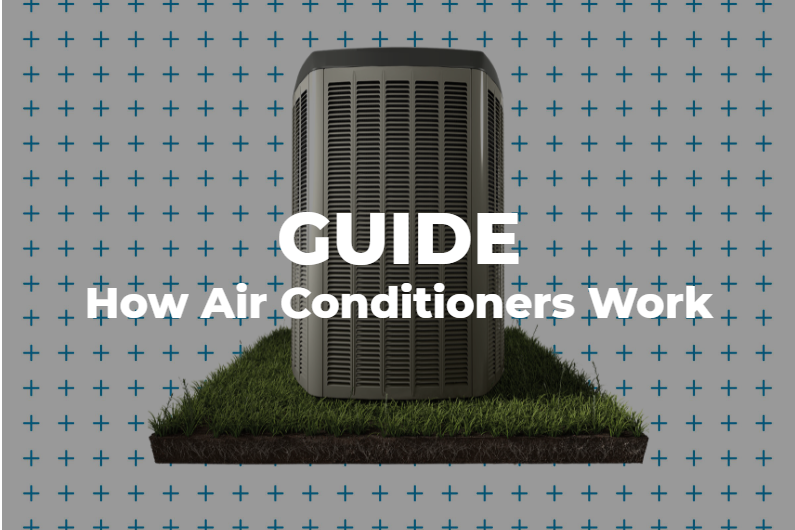Wondering how air conditioners work? Being aware of how your A/C works can give you the information you need to keep your A/C in top condition, as well as work out what to do to resolve any problems that develop.
Read on to discover how your air conditioning works, as well as understand the signs to look out for that could indicate that your system needs attention.
How Your Air Conditioner Works
The air conditioning process largely relies on physics! If gas is subjected to increased pressure, its temperature rises (provided its volume remains constant). In contrast, if a gas experiences a reduction in pressure (at constant volume), its temperature will decrease. It is this principle that explains how air conditioners transfer heat from one place to another.
The Role of Freon
The gas which is used in A/C to achieve heat transfer between the interior of your property and the exterior is Freon. Freon always contains fluorine and carbon. It may also contain other halogens, such as chlorine and/or bromine. Some Freon compounds are classed as chlorofluorocarbons (CFCs), others are classed as hydrochlorofluorocarbons (HCFCs).
Despite the different chemical compositions that different types of Freon may have, all variants are characterized by:
- High latent heat (which means the compound takes up a considerable amount of heat as it changes state from liquid to gas).
- A high critical temperature. The critical temperature is the temperature at which a gas won’t readily condense back into liquid form, even with the use of a compressor. Obviously, the higher this is, the more heat the gas can absorb and still work successfully in an A/C unit.
- Low toxicity, low flammability, and non-corrosive. Provided Freon is handled and stored correctly, it’s perfectly safe for use in A/C units.
The Compressor, Condensor and Evaporator
There are three main, working components in an A/C system - the compressor, the condenser, and the evaporator.
The compressor, typically located outside the property in the main A/C unit, applies pressure to gas, creating a change in temperature.
The condenser, again, located outside the property, is a structure that consists of numerous small fins. These provide a large surface area to assist heat transfer from the gas to the outside.
Indoors you’ll find the evaporator. This piece of the system is where the liquid is evaporated into gas, taking heat from the surroundings to create the required cooling effect.
The Cooling Cycle
If we start inside the property, Freon will pass from outside to indoors along a narrow tube. At the end of this tube, it will enter the evaporator (which is located inside the property). At this point, the Freon in the system is under very little pressure (in a low-pressure environment). What this means is that, as pressure is low, the liquid Freon begins to evaporate into gaseous form.
The Evaporator
The evaporation requires heat energy to fracture the bonds between the Freon molecules to enable them to change states from liquid to gas. The heat is drawn from the air outside the evaporator - ie: the air inside your home. During the evaporation process, the air in your home will experience a drop in temperature, as the Freon is drawing heat out of it to evaporate.
You will notice that your A/C evaporator is covered by small fins. These increase surface area, enabling greater heat transfer from the air to the Freon in a shorter period of time. Once the Freon has passed through the evaporator, it’s been transformed from a cool liquid to a cool gas.
Note that the temperature of the Freon doesn’t rise markedly - due to Freon’s high latent heat, the heat from the air inside your home is used to fracture the bonds between molecules, rather than to increase the temperature of the gas. Freon usually stays between 40°F and 50°F at all times during the A/C cycle.
The Compressor
Freon exists the evaporator as a cool gas and is transported on the next stage of its journey to the compressor. The compressor is powered by an electric pump. As the name suggests, the compressor compresses the Freon, increasing the pressure it’s under. When a gas is put under increased pressure, its temperature begins to rise.
By the time the Freon leaves the compressor, the gas is at its hottest and under the greatest pressure.
The Condensor
Hot, compressed Freon is transported to the condenser. This is where it uses a considerable amount of its heat. The heat passes through the fins of the condenser unit into the outside air. As heat is dissipated from the Freon, its temperature begins to drop, although it is still at high pressure.
A drop in temperature causes a change in state, with the Freon condensing from gas to liquid state. The liquid Freon passes through a pipe and aperture into the evaporator. At this point, it passes from a high-pressure environment to a low-pressure environment, ready to start collecting heat from the interior so that it can change state from liquid to gas again.
The number of times the cycle is completed is controlled by the thermostat. Once the desired temperature is reached, the thermostat will trigger the electric engine operating the compressor to cut out, stopping the gas circulation. As the interior temperature starts to rise, the thermostat will send a signal to the compressor to begin operating, causing the cooling process to restart.
How Does the Cool Air Circulate Inside my Home?
As well as providing a location in which evaporation can occur, the evaporator also contains a powerful fan. The fan blows cold air from the evaporator into the vents that carry the cold air to each room in your home. At the same time, the fan also draws warm air through a vent and across the little fins on the evaporator. This action provides the warm air needed to pass into the evaporator and give up its heat to the Freon.
Does my A/C use Fresh air?
No! It is the heat that’s transferred from the air inside your home to the air outside during the air conditioning process. Although warm interior air enters the evaporator vent and, following cooling, is ejected back into the home via the ducts, the air remains the same.
This is one of the reasons why it’s imperative to make sure your ducts and air filter are spotless, as otherwise, you (and the other occupants of your home) will be breathing in air that’s tainted by dirt, mold, and other contaminants from dirty ducts or a filthy filter.
How do I Know When Something is Wrong With my A/C?
Provided you’ve had the correct system installed for the size and layout of your property, a well-maintained system will last for decades in most cases. A/C problems tend to be more common in units that are fifteen years old or more, and/or which haven’t been regularly maintained.
Signs that your A/C could require attention from a professional technician include:
- Failure to keep your property at the desired temperature.
- An unpleasant smell in your home that doesn’t have an obvious cause.
- An A/C unit that makes strange noises or clearly sounds as if it’s straining.
- A system that takes a very long time to reach the required temperature.
- A system that cuts out intermittently.
If you notice any of these issues, it’s important to seek professional assistance as soon as you can. Problems such as low levels of Freon will mean your system is working overtime to keep your home at the correct temperature. This greatly increases the risk of a mechanical breakdown.
Similarly, if ducts are blocked by detritus (which naturally falls from the air as it circulates through the ducts), the system will have to work harder to cope. Similarly, this increases the possibility of a breakdown.
Professional Maintenance is one of the Best Ways to Keep Your A/C Working Well
Regular servicing brings a number of benefits to your A/C. These include:
- Prolonging the life of your system.
- Ensuring optimal energy efficiency.
- Reducing strain on the mechanical parts of your system.
- Ensuring optimal efficiency.
- Reducing the risk of sudden failure (which could require a costly repair).
- Ensuring optimal performance, keeping your home cool when you need it.
Problems With Your A/C? We can help.
Air Force Air Conditioning and Heating offer a total HVAC solution, including repairs, servicing, maintenance, inspection, replacement, and fresh installations.
Experienced, professional, licensed, and bonded, you can rely on the team at Air Force to successfully complete work on A/C make or model. We service A/C units across the Conejo Valley and San Fernando Valley, CA.
Contact Air Force Air Conditioning and Heating for more information on fast, efficient, and competitively priced A/C services.



